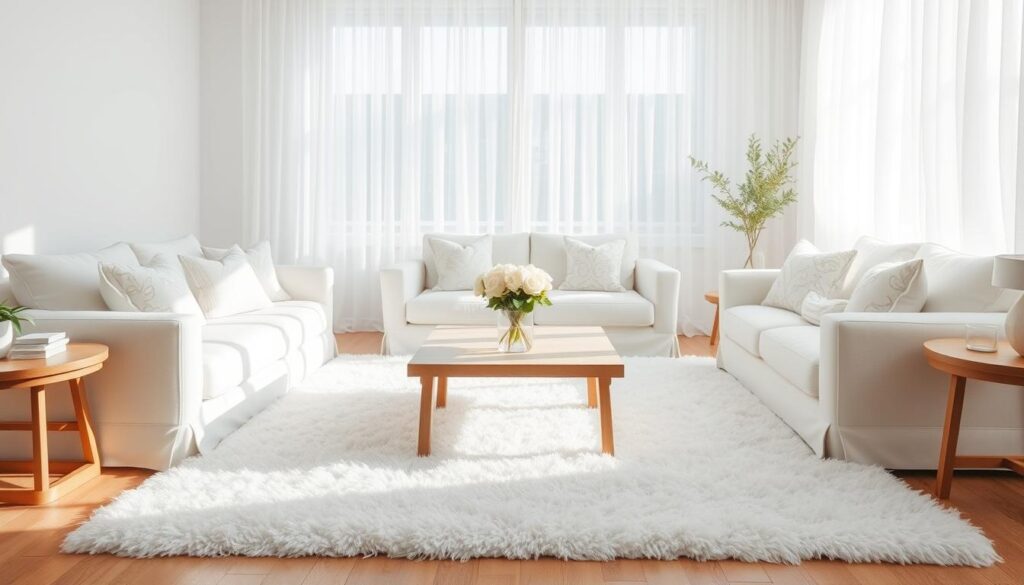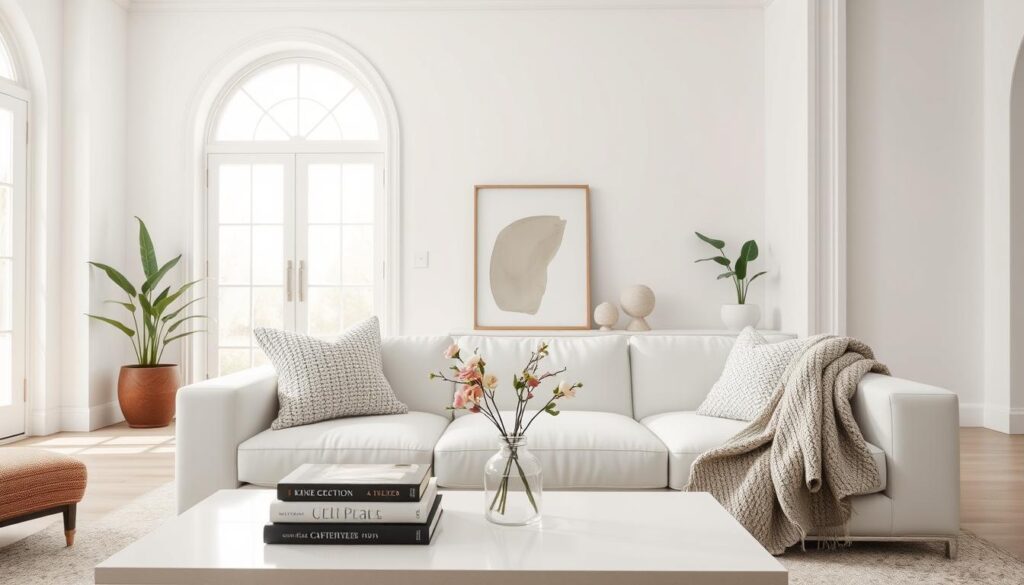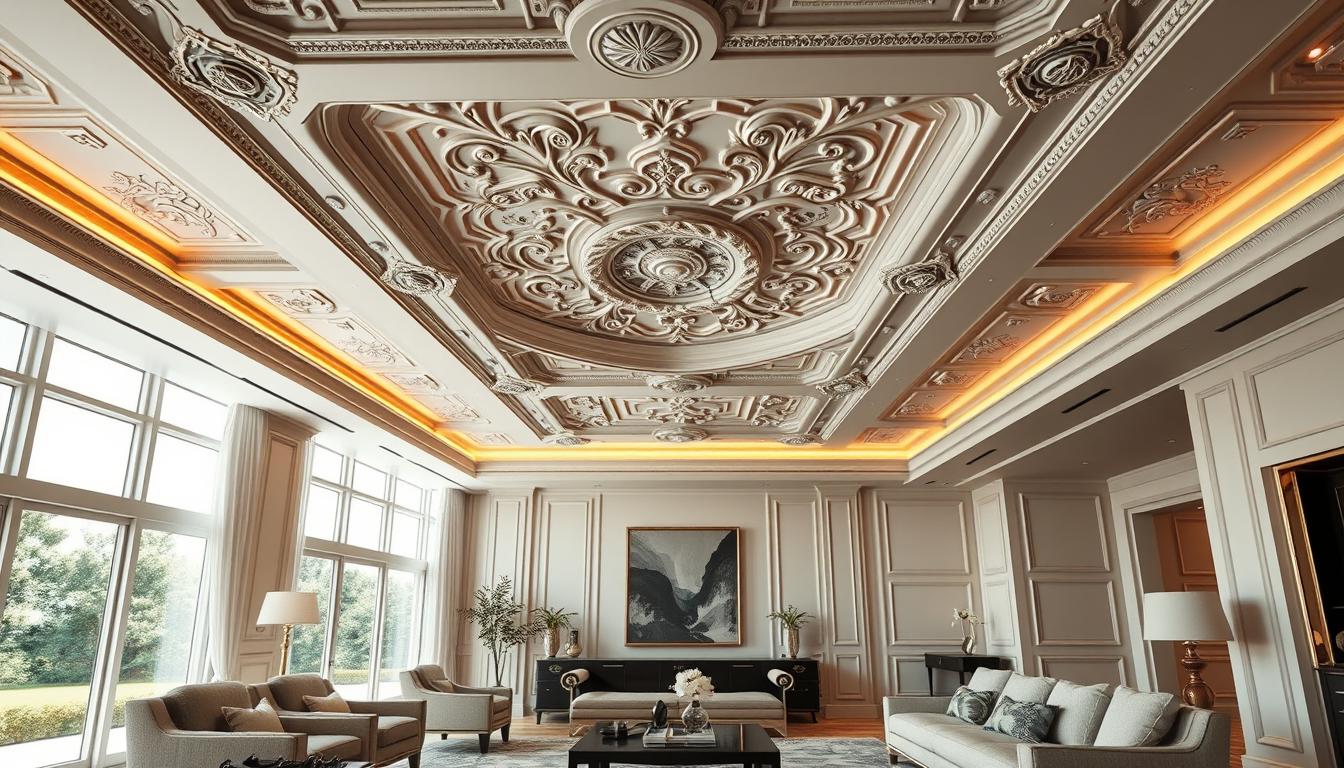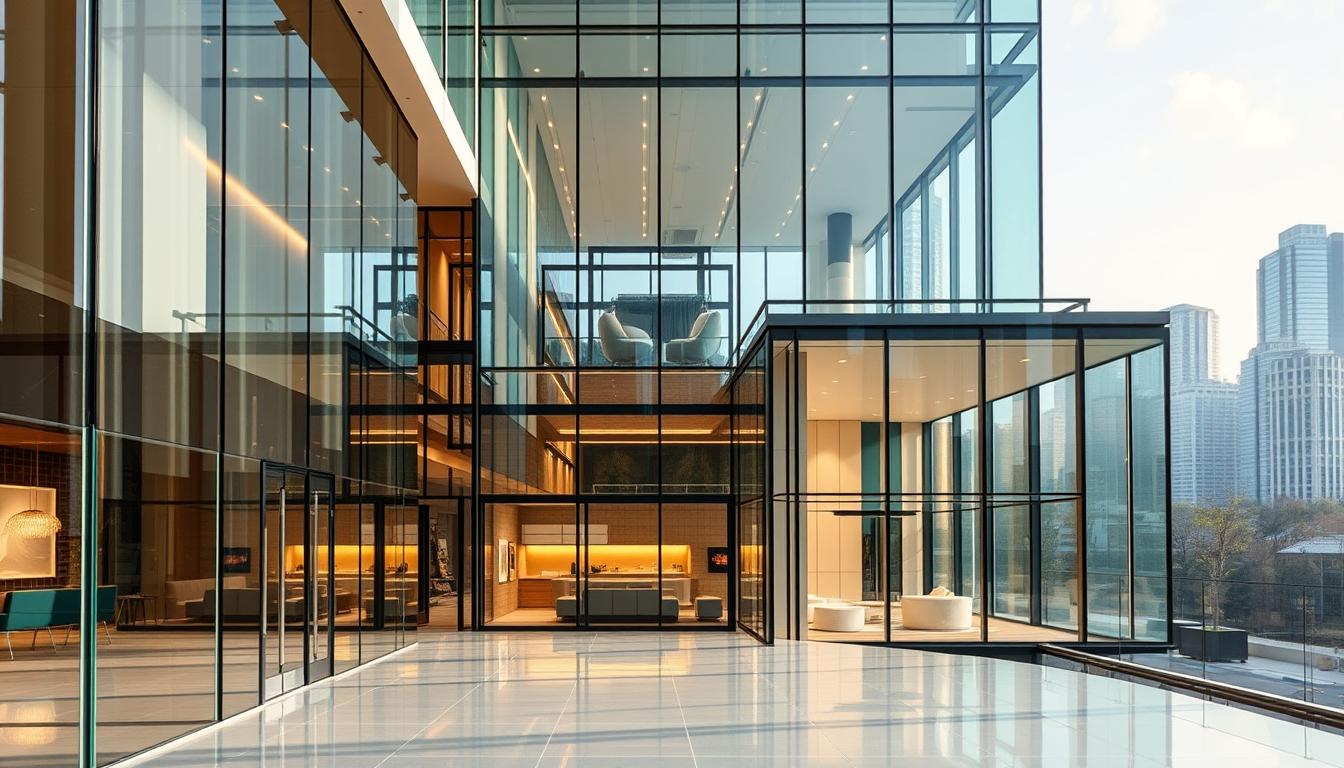All-white interiors are often seen as plain or boring. But, when done right, they can be stunning. Experts say, “all-white interiors are far from plain. They shine with natural light and textures.”
A well-designed white interior can make a room feel bright and modern. Adding different textures and natural light makes the space elegant and welcoming.
Key Takeaways
- Create a layered look with different textures
- Incorporate natural light to enhance the space
- Use minimalist decor to avoid clutter
- Choose the right shade of white for your walls
- Balance white with other colors to add depth
Why Choose White for Home Interiors?
White is a timeless choice in interior design. It fits many decorating styles, from Scandinavian design to traditional. Using white in your home is more than a design choice. It greatly affects the feel and function of your space.
The Psychology of Color in Design
Color psychology is key in interior design. White is calming and brings a sense of peace. It makes rooms feel bigger and more relaxed. A recent article on color power in interiors shows white works well in every room.
Timeless Elegance of White
White interiors are timeless and elegant. Unlike bold colors, white stays in style. It’s perfect for those who want a beautiful, elegant home interior that lasts.
Benefits of a White Palette
What are the benefits of a white color palette? Here are some key points:
- Makes a room appear larger and more spacious
- Creates a sense of calm and serenity
- Provides a clean and minimalist aesthetic
- Is versatile and can be paired with a variety of colors and design styles
- Can help to reflect natural light, making a room brighter
Choosing a white color palette can make your home feel open and welcoming. Whether you’re into Scandinavian design or just want a bright interior, white is a great choice.
Key Elements of White Home Interior Design
White home interior design is all about simplicity and elegance. To make a space beautiful and inviting, we need to focus on a few key things.
Walls and Ceilings
The base of a white interior is the walls and ceilings. Picking the right white paint is key. Think about the natural light and the colors of your furniture and decor.
A pure white can make a room feel bright and airy. A softer white can add warmth. When choosing paint, consider the finish too. A flat finish hides imperfections, while a semi-gloss adds sophistication. For ceilings, a flat finish is best to avoid glare.
Flooring Options
Flooring greatly affects the feel of your white interior. Hardwood flooring in a light finish looks great with white walls, adding warmth and texture. White or light-colored tile can give a seamless, contemporary interior styling look.
For a natural touch, consider white furniture trends with natural wood or woven fibers. This adds depth and interest to your space.
Furniture Selection
Choosing the right furniture is crucial for a white interior. Go for furniture with clean lines and little decoration to keep the space bright and airy. White or light-colored upholstery reflects light and makes rooms feel larger.
To avoid a cold feel, add different textures with throw pillows, blankets, and rugs. This adds warmth and makes your space more inviting, fitting with white furniture trends.
By focusing on walls, ceilings, flooring, and furniture, you can create a stunning white home interior. It will be both elegant and welcoming.
Enhancing Brightness with White Interiors
Adding white to your home’s interior can really brighten it up. A well-done white interior looks great and makes the space feel open and airy.
Natural Light Considerations
Getting as much natural light as possible is key for a white interior. Sheer curtains or leaving windows bare help a lot. Design experts say, “Using sheer curtains or leaving windows bare can make a room feel more spacious and airy.”
Artificial Lighting Techniques
Natural light is great, but sometimes it’s not enough, like at night or in dark rooms. That’s when artificial lighting techniques come in handy. A mix of overhead lights, table lamps, and floor lamps can brighten up a room. For a modern look, try LED lights or smart systems that adjust brightness.
“The right lighting can transform a room, making it feel more spacious and enhancing the beauty of a white interior.”
Reflective Surfaces and Materials
Reflective surfaces and materials also boost the brightness of a white interior. Mirrors, glossy finishes, and metallic accents bounce light around, making the room feel brighter. Think about the look you want, from simple to luxurious.
By using natural light, artificial lighting, and reflective surfaces, you can make a white interior bright and welcoming. It will feel spacious and inviting.
Textures and Patterns in White Design
To avoid a sterile look, elegant home interiors often mix textures and patterns in white design. This creates a rich, inviting space that feels both modern and cozy.
Incorporating Soft Fabrics
Soft fabrics add warmth to a white interior. Use plush throw blankets, velvet pillows, and soft rugs for a cozy feel. These elements add texture and invite touch, making the space welcoming.
A velvet sofa in a white room can be a focal point, adding texture and luxury. Linen drapes filter natural light, creating a soft glow that enhances the room’s ambiance.

Mixing Different Textures
Mixing textures creates depth in a white home interior design. Layering fabrics, wood, metal, and other materials makes the space visually interesting. For example, a smooth marble coffee table with a chunky woven rug and a velvet sofa creates a dynamic environment.
Design experts say layering textures adds depth and interest to an all-white space. This allows homeowners to try different materials and styles, from modern metallics to rustic wood.
Patterns that Complement White
While white interiors are minimalist, patterns can add complexity and interest. Use subtle patterns like gentle florals, soft geometrics, or delicate stripes to complement the white.
| Pattern Type | Description | Example |
|---|---|---|
| Floral | Delicate, soft designs that add elegance | White on white embroidered fabrics |
| Geometric | Simple, repetitive patterns for visual interest | Hexagonal tiles, geometric rugs |
| Stripes | Classic, timeless patterns for a dynamic element | Striped upholstery, striped wallpaper |
By carefully adding textures and patterns, homeowners can create a contemporary interior styling that’s both beautiful and functional. Whether through soft fabrics, mixed textures, or subtle patterns, the options for enhancing a white interior are endless.
Creating Contrast in an All-White Space
An all-white interior can be calming, but it needs contrast to avoid feeling dull. A good contrast can make your modern white interiors more interesting.
To add contrast, use accent colors. You can do this with items like vases, throw pillows, or art. For example, a bright red vase can stand out against white, making a bold statement.
Adding Accent Colors
Accent colors can be soft or bold. They should match the white without taking over. Soft blues and greens can calm the space, while bright yellows and oranges can add energy.
Using Darker Elements
Darker elements can also create contrast. Think about a dark wood coffee table or a black metal lamp. These add depth and prevent the space from feeling too empty.
In minimalist home decor, charcoal or black accessories can add elegance. For example, black-and-white art can make an all-white room more interesting and balanced.
Importance of Visual Contrast
Visual contrast keeps a white color palette looking good. It stops the space from feeling flat. By adding contrasting elements, you make the space lively and welcoming.
Creating contrast in an all-white space is all about finding the right mix. Use accent colors, darker elements, and smart design to get a stunning interior.
The Role of Accessories in White Interiors
White interiors are like a blank canvas. Accessories add the final touches, bringing life and personality to the space. They help make the home look elegant and stylish.
Decor That Pops
To make a white space pop, we can add bold decor. This includes bold artwork, colorful throw pillows, and unique pieces. For example, a bright vase or a special sculpture can stand out in the room.

Functional Accessories
Functional accessories are key for both looks and use. In modern homes, items like woven baskets and stylish lights are perfect. They keep the space tidy and add to its beauty.
Art and Wall Hangings
Art and wall hangings bring character to white spaces. We can pick items that match the white theme, like black and white photos or abstract art. These add depth and prevent the space from feeling dull.
| Accessory Type | Purpose | Examples |
|---|---|---|
| Decorative | Aesthetic appeal | Vases, sculptures, artwork |
| Functional | Practical use | Baskets, storage units, lighting |
| Art and Wall Hangings | Character and texture | Photography, abstract art, textiles |
Choosing the right accessories makes a white home both beautiful and useful. Whether it’s bold decor, practical items, or art, the right touches can make a space truly unique.
White Kitchen Design Ideas
A white kitchen is loved for its light reflection and spacious feel. It’s a favorite among homeowners. A well-designed white kitchen is the heart of the home, blending function with brightness.
We’ll look at key elements for this look. This includes cabinets, countertops, and creating a cozy feel.
Cabinets and Countertops
Cabinets and countertops are key in white kitchen design. White Shaker cabinets offer a clean, simple look. They match well with many countertop materials.
For countertops, white quartz or marble adds elegance. They’re also durable and practical.
Backsplash Inspirations
A backsplash adds a big visual touch to your kitchen. Use white subway tiles for a classic look. Or try glass or metallic tiles for something modern.
The goal is to find a balance. This balance should enhance the design without overwhelming it.
Creating a Cozy Atmosphere
White kitchens can feel cold. To warm them up, add warm lighting and natural textures. Wooden accents or exposed brick add warmth, mixing industrial with modern.
Textiles like kitchen rugs and towels also add color and warmth. They make the kitchen feel welcoming. Balance the white with these elements for a cozy, inviting space.
White Living Room Inspirations
To make a stunning white living room, think about light and texture. A well-planned white living room is calm and welcoming. It mixes elegance with comfort perfectly.
Furniture Arrangement
Choosing where to put your furniture is key. Start with a neutral sofa. Then, add chairs or ottomans in matching colors.
Here are some tips for arranging furniture:
- Set up the sofa for easy conversation.
- Choose a coffee table that matches the sofa and looks good.
- Use either symmetrical or asymmetrical layouts to balance the room.
Choosing the Right Accents
Accents are crucial for a white living room’s feel. Add contrasts and interest with throw pillows, rugs, and wall art.
Some great accent ideas are:
- Gold or silver for a luxurious touch.
- Wood or plants for warmth.
- Bold artwork or colorful vases for a focal point.
Cozy Textiles for Comfort
Adding soft textures makes a white living room cozy. Use velvet, linen, or cotton for furniture, blankets, and pillows.
| Textile | Benefits | Best Use |
|---|---|---|
| Velvet | Luxurious feel, rich colors | Accent pillows, upholstery |
| Linen | Natural look, breathable | Throw blankets, curtains |
| Cotton | Soft, versatile, easy to clean | Pillows, upholstery, rugs |
By mixing furniture, accents, and soft textures, you can craft a white living room that’s both stylish and comfy.
Designing a Serene Bedroom in White
A white bedroom can be a peaceful retreat. Using a white color palette brings calmness and serenity. It’s perfect for a good night’s sleep.
Bed Linens and Decor
Choosing the right fabric for bed linens is important. Go for soft, breathable materials like cotton or linen. For decor, add subtle patterns or textures to avoid a sterile feel. Check out more white bedroom ideas for inspiration.
Creating a Relaxing Ambiance
To make a white bedroom relaxing, add elements of Scandinavian design. This means simple, clean furniture and lots of natural light. Adding plants can also warm up the space, as experts suggest.
White Space Management
Managing white space well is key to avoiding clutter. Balance is essential. Make sure there’s enough empty space to keep things calm. Choose a few statement pieces and leave room around them.
Designing a white bedroom thoughtfully can make it a bright and airy home design. It should feel serene yet inviting. The goal is to find a balance between clean and cozy, making the space relaxing and comfy.
Outdoor Spaces with White Elements
Adding white elements to our outdoor spaces makes them inviting and cohesive. This choice not only beautifies our homes but also connects indoor and outdoor areas smoothly.
White Patios and Furniture
White patio furniture is key to modern white interiors. It makes your outdoor area look bigger and fresher. When picking white patio furniture, look for materials that last and handle the weather well.
Some top picks include:
- Synthetic wicker furniture for its durability and easy care
- Cast aluminum furniture for being light and resistant to rust
- Recycled plastic furniture for being eco-friendly and versatile
To keep your white patio furniture looking great, clean it often. A mix of mild soap and water works well to remove dirt and stains.
Landscaping Considerations
Landscaping is key when using white in your outdoor space. Contrasting colors add interest. For example, dark plants or flowers with white blooms add depth and beauty to your garden.
| Plant Type | Characteristics | Benefits |
|---|---|---|
| White Roses | Fragrant, romantic blooms | Adds a touch of elegance |
| Dusty Miller | Silver-gray leaves | Provides contrast to green foliage |
| Shasta Daisies | Bright white petals, yellow center | Attracts pollinators, adds cheerfulness |
Enhancing Curb Appeal
White elements boost your home’s curb appeal. Painting your front door white or adding white trim makes a bold statement. White outdoor decor, like planters or a welcome mat, adds warmth and welcome to your home’s exterior.
“A well-designed outdoor space can increase a home’s value and appeal. Incorporating white elements is a timeless choice that can enhance both the exterior and interior of a home.”
By adding white elements to your outdoor space, you create a beautiful and welcoming area. Whether through furniture, landscaping, or curb appeal, white brings cohesion and style to your outdoor living areas.
Common Mistakes in White Interior Design
White home interior design is elegant but tricky. An all-white space can feel cold if not done right. Interior design experts warn about this.
Pitfalls of an Overly White Palette
Too much white can make a space feel empty. To fix this, add minimalist decor that brings texture and interest. This makes your home elegant and lively.
Balancing Style and Functionality
Ignoring functionality is a big mistake. We need to find a balance. Choose furniture and accessories that are both stylish and useful.
By avoiding these common mistakes, we can make a white home that’s both beautiful and practical. It will be elegant and sophisticated.


